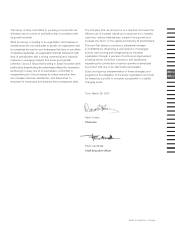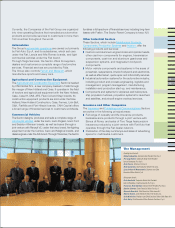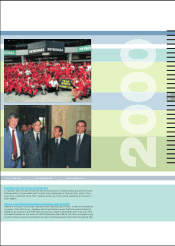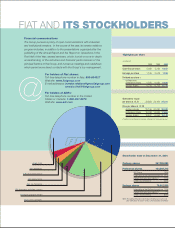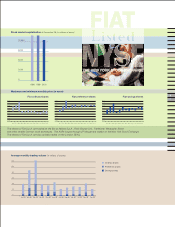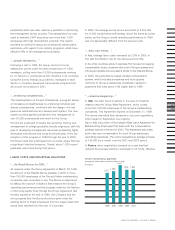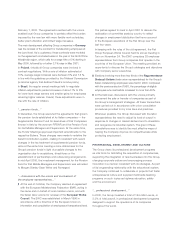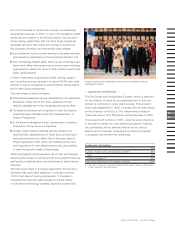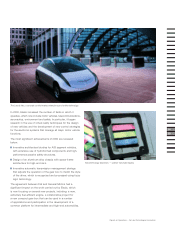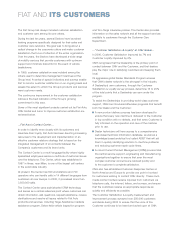Chrysler 2000 Annual Report Download - page 23
Download and view the complete annual report
Please find page 23 of the 2000 Chrysler annual report below. You can navigate through the pages in the report by either clicking on the pages listed below, or by using the keyword search tool below to find specific information within the annual report.
HUMAN RESOURCES AND ORGANIZATIONAL
DEVELOPMENT
The net effect of several large staff additions and reductions
was an increase of 2,634 units in the Group’s workforce,
which totaled 223,953 employees at December 31, 2000,
compared with 221,319 at the end of 1999.
The Group hired 17,200 new employees in 2000 — 5,300
in Italy and 11,900 in other countries. Business acquisitions
and divestitures completed during the year resulted in a net
increase of 12,700 employees.
Number of employees at 12/31/99 221,319
Additions 17,200
Reductions (23,366)
Outsourcing (3,900)
Changes in the scope of consolidation 12,700
Number of employees at 12/31/00 223,953
“…evolution of the organizational structure…”
The Group’s organization underwent major changes as a result
of transactions carried out to implement a strategy based on
focusing its core businesses, expanding globally, lengthening
the value chain and reducing complexity.
One obvious consequence of these efforts is the shift in the
geographical distribution of the Group’s staff. Over the last 10
years, the number of employees working outside Italy has grown
steadily and now amounts to half of the total workforce.
During 2000, several Sectors (Automobiles, Agricultural and
Construction Equipment, Production Systems, Commercial
Vehicles) were busy integrating the operations of newly or
recently acquired companies, with the goal of developing
synergies that are expected to generate savings of about
2 billion euros by 2005.
In particular, the two joint ventures established under the
industrial alliance between Fiat and General Motors have
become operational, and the scope of their worldwide
activities and respective management responsibilities have
been defined. About 500 employees of Fiat Auto have already
been moved to GM-Fiat Worldwide Purchasing. The remaining
reassignments to GM-Fiat Worldwide Purchasing and Fiat-GM
Powertrain, affecting about 14,000 employees, will be
completed in the early part of 2001.
The transfer of assets and human resources to service
companies within the Group involved more than 2,900 people
in Italy and abroad. The companies most affected by this
change were Comau Service (maintenance of manufacturing
facilities), Ingest Segim (maintenance of industrial buildings)
and Fenice (environment, energy and water treatment). Non-
core businesses with about 3,900 employees were divested
during the year. Several Group companies that specialize
in providing business services were combined into a new
Services Sector, which is headed by Business Solutions.
A detailed description of this Sector is provided in the
Fiat Services section of this report.
“…process reengineering…”
The streamlining of the Group’s operations continued with
the implementation of the Nova Project, which produced the
desired results, reducing the cost of support activities by
20% over two years. At the same time, all the Sectors began
to carry out incisive programs to radically reengineer their
internal processes and make them significantly more efficient
and effective. These programs, which will be the focus of
management’s attention for the next few years, are being
supported with an ambitious effort to provide training in
process reengineering methods and by establishing an
organization that includes a resource team and a process
owner for each of the processes involved. An added benefit
of this approach is that it enables the Company to proceed
simultaneously with the testing of new organizational models
within the framework of a process-oriented company.
“…leadership in the management of human resources…”
To facilitate the achievement of competitive excellence goals, the
Group defined the leadership behaviors that managers must
employ to handle human resources in a manner conducive
to enhancing their professional skills and increasing their
involvement, motivation and empowerment. To help managers
put these principles into practice, the Group developed a detailed
communications program, adopted comprehensive leadership
assessment systems (assessment centers and auditing) and
provided structured training programs.
FIAT AND ITS PEOPLE
1991 2000
9%
15%
76%
50%
24%
26%
Rest of Europe Rest of the worldItaly



